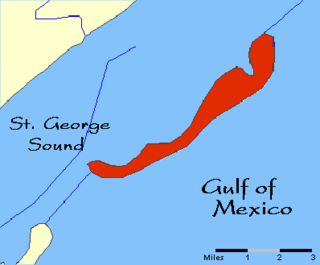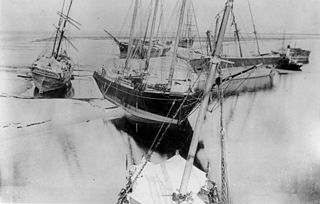
Maritime archaeology is a discipline within archaeology as a whole that specifically studies human interaction with the sea, lakes and rivers through the study of associated physical remains, be they vessels, shore-side facilities, port-related structures, cargoes, human remains and submerged landscapes. A specialty within maritime archaeology is nautical archaeology, which studies ship construction and use.

Underwater archaeology is archaeology practiced underwater. As with all other branches of archaeology, it evolved from its roots in pre-history and in the classical era to include sites from the historical and industrial eras. Its acceptance has been a relatively late development due to the difficulties of accessing and working underwater sites, and because the application of archaeology to underwater sites initially emerged from the skills and tools developed by shipwreck salvagers. As a result, underwater archaeology initially struggled to establish itself as bona fide archaeological research. The situation changed when universities began teaching the subject and when a theoretical and practical base for the sub-discipline was firmly established. Underwater archaeology now has a number of branches including, after it became broadly accepted in the late 1980s, maritime archaeology: the scientifically based study of past human life, behaviours and cultures and their activities in, on, around and (lately) under the sea, estuaries and rivers. This is most often effected using the physical remains found in, around or under salt or fresh water or buried beneath water-logged sediment. In recent years, the study of submerged WWII sites and of submerged aircraft in the form of underwater aviation archaeology have also emerged as bona fide activity.

Santa Rosa County is a county located in the northwestern portion of the U.S. state of Florida. As of the 2010 Census, the population was 151,372. The county seat is Milton, which lies in the geographic center of the county. Other major communities within Santa Rosa County are Navarre, Pace, Milton, and Gulf Breeze.

The Florida Panhandle is the northwestern part of the U.S. state of Florida, is a strip of land roughly 200 miles (320 km) long and 50 to 100 miles wide, lying between Alabama on the north and the west, Georgia on the north, and the Gulf of Mexico to the south. Its eastern boundary is arbitrarily defined.

Dog Island is located in the northwestern Florida Gulf coast just 3.5 mi (5.6 km) off-shore from Carrabelle in Franklin County, Florida.

USS Narcissus — a screw steamer launched in July 1863 as Mary Cook at East Albany, N.Y. — was purchased by the Union Navy at New York City on 23 September 1863 from James D. Stevenson; and commissioned at New York Navy Yard on 2 February 1864, Acting Ensign William G. Jones in command.

The maritime history of Florida describes significant past events relating to the U.S. state of Florida in areas concerning shipping, shipwrecks, and military installations and lighthouses constructed to protect or aid navigation and development of the Florida peninsula.

The Dog Island Light was located on the western tip of Dog Island south of Carrabelle, Florida. It marked the "middle entrance to St. George's Sound," between St. George and Dog Islands, during the nineteenth century, until its collapse by a hurricane in 1873.
James Preston Delgado, Ph.D. is a maritime archaeologist, historian, maritime preservation expert, author, television host, and explorer.

City of Hawkinsville was a paddle steamer constructed in Georgia in 1886. Sold in 1900 to a Tampa, Florida company, it delivered cargo and lumber along the Suwannee River. Eventually rendered obsolete by the advent of railroads in the region, it was abandoned in the middle of the Suwannee in 1922.
The history of Pensacola, Florida, begins long before the Spanish claimed founding of the modern city in 1698. The area around present-day Pensacola was inhabited by Native American peoples thousands of years before the historical era.

The Georges Valentine Shipwreck Site is the site of the historic shipwreck of an Italian barkentine off the coast of Hutchinson Island in Martin County, Florida, with the nearest landmark being the House of Refuge at Gilbert's Bar.

George Robert Fischer was an American underwater archaeologist, considered the founding father of the field in the National Park Service. A native Californian, he did undergraduate and graduate work at Stanford University, and began his career with the National Park Service in 1959, which included assignments in six parks, the Washington, D.C. Office, and the Southeast Archaeological Center from which he retired in 1988. He began teaching courses in underwater archaeology at Florida State University in 1974 and co-instructed inter-disciplinary courses in scientific diving techniques. After retirement from the NPS his FSU activities were expanded and his assistance helped shape the University's renowned Program in Underwater Archaeology.
Michael Alexander Arbuthnot is an archaeologist, instructor and archaeological filmmaker.
Judith Ann Bense is an American academic, Florida historical archaeologist, and a former president of the University of West Florida. She is also the chairwoman of the Florida Historical Commission At the University of West Florida, she served as a faculty member and department chair in the anthropology program, which she started at the school. In 2008, she started her 7-year term as president of the university. Prior to this promotion, she was the former executive director of anthropology and archaeology at UWF. During her career, she was fundamental in drafting the legislation to create the Florida Public Archaeology Network (FPAN)[1].

James A. Garfield was an American three-masted bark which was wrecked on the Gulf coast of Florida.

The Gulf of Mexico is an ocean basin and a marginal sea of the Atlantic Ocean, largely surrounded by the North American continent. It is bounded on the northeast, north and northwest by the Gulf Coast of the United States, on the southwest and south by Mexico, and on the southeast by Cuba. The US states of Texas, Louisiana, Mississippi, Alabama, and Florida border the Gulf on the north, which are often referred to as the "Third Coast", in comparison with the U.S. Atlantic and Pacific coasts.

Charles T. Meide, Jr., known as Chuck Meide, is an underwater and maritime archaeologist and currently the Director of LAMP, the research arm of the St. Augustine Lighthouse & Maritime Museum located in St. Augustine, Florida. Meide, of Syrian descent on his father's side, was born in Jacksonville, Florida, and raised in the nearby coastal town of Atlantic Beach. He earned BA and MA degrees in Anthropology with a focus in underwater archaeology in 1993 and 2001 from Florida State University, where he studied under George R. Fischer, and undertook Ph.D. studies in Historical Archaeology at the College of William and Mary starting the following year. Meide has participated in a wide array of shipwreck and maritime archaeological projects across the U.S., especially in Florida, and throughout the Caribbean and Bermuda and in Australia and Ireland. From 1995 to 1997 he participated in the search for, discovery, and total excavation of La Salle's shipwreck, La Belle, lost in 1686. From December 1997 to January 1998 he served as Co-Director of the Kingstown Harbour Shipwreck Project, an investigation sponsored by the Institute of Maritime History and Florida State University into the wreck of a French frigate lost in 1780 in St. Vincent and the Grenadines. In 1999 he directed the Dog Island Shipwreck Survey, a comprehensive maritime survey of the waters around a barrier island off the coast of Franklin County, Florida, and between 2004 and 2006 he directed the Achill Island Maritime Archaeology Project off the coast of County Mayo, Ireland. Since taking over as Director of LAMP in 2006, he has directed the First Coast Maritime Archaeology Project, a state-funded research and educational program focusing on shipwrecks and other maritime archaeological resources in the offshore and inland waters of Northeast Florida. In 2009, during this project, Meide discovered the "Storm Wreck," a ship from the final fleet to evacuate British troops and Loyalist refugees from Charleston at the end of the Revolutionary War, which wrecked trying to enter St. Augustine in late December 1782. He led the archaeological excavation of this shipwreck site each summer from 2010 through 2015. Starting in 2016, Meide has directed the ongoing excavation of the "Anniversary Wreck," another 18th-century shipwreck believed to represent a merchant vessel lost while trying to enter St. Augustine.
Josephine was an American iron-hull, sidewheel steamer that transported mail, freight, and passengers, in the Gulf of Mexico, mainly between New Orleans, Louisiana and Galveston, Texas, beginning in 1868. In 1881, the Josephine was transferred to the New Orleans – Havana route. Returning from Havana in February 1881, the Josephine encountered a winter storm in the Gulf of Mexico, south of Biloxi, Mississippi, took on water and sank, but all passengers and crew survived. In 2000, the Josephine shipwreck was listed on the National Register of Historic Places.
SS Florinda was a 57-foot (17 m) double-masted schooner constructed on the Tangipahoa River to the north of New Orleans in 1845 and engaged in the lake trade on the Northern Gulf Coast. Under the command of owner Harmon Jones and Captain James Kenmure, she sailed on July 6, 1849 from New Orleans for the California Gold Rush and was feared lost at sea with all hands while sailing around Cape Horn. Twenty-six years later, reports of the crew living as castaways on an uncharted island in the Straits of Magellan mysteriously surfaced.












